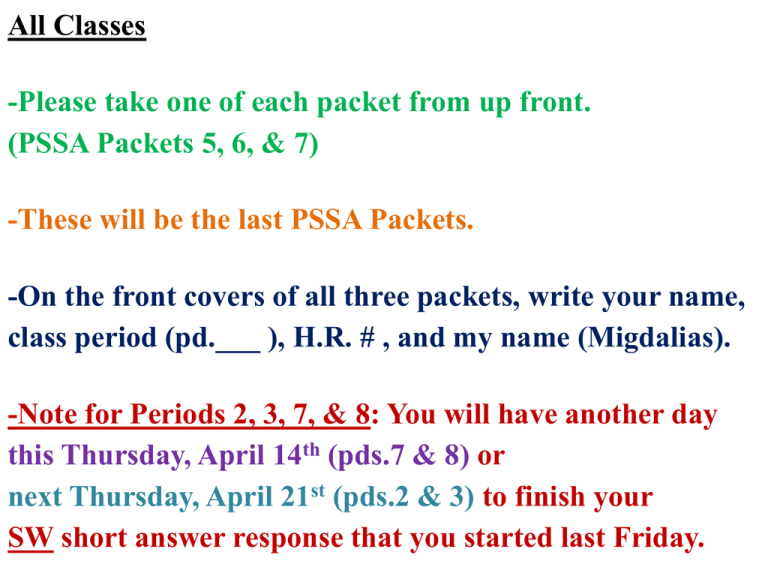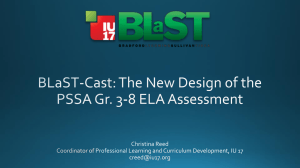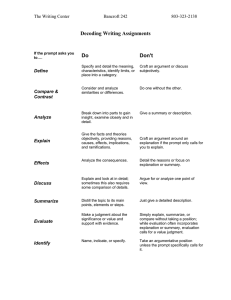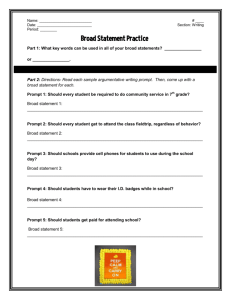All Classes -Please take one of each packet from up front.
advertisement

All Classes -Please take one of each packet from up front. (PSSA Packets 5, 6, & 7) -These will be the last PSSA Packets. -On the front covers of all three packets, write your name, class period (pd.___ ), H.R. # , and my name (Migdalias). -Note for Periods 2, 3, 7, & 8: You will have another day this Thursday, April 14th (pds.7 & 8) or next Thursday, April 21st (pds.2 & 3) to finish your SW short answer response that you started last Friday. NEW SEATS! Before we begin, let’s switch th seats for the 4 marking period! Get all of your belongings in one pile, and be ready to stand with them in the back of the room when I tell you to. Welcome to the ELA PSSA 2016 Grades 7 and 8 Week of April 11th Pennsylvania System of School Assessment PSSA Grades 3 - 8 Keystones in Grade 10 SAT Grade 11 Pennsylvania System of School Assessment Measures growth and mastery of key concepts and skills to help you become high school, college, and career ready. How will the PSSA assess ELA in Grades 4-8? 23 Core Passage MC items 18 Core stand-alone MC items (Grammar) 3 two-point EBSR items 3 three-point EBSR items 1 four pt TDA weighted x4 1 four pt prompt weighted x3 6 23 pts 18 pts 6 pts 9 pts 16 pts 12 pts 41 43 Get a good night’s sleep Eat a good breakfast Follow ALL directions Read each question carefully (especially multiple choice questions that ask for the best answer or more than one answer) Mark your answers in the right spots Keep your eyes on your own test Answer each item and check your work When in doubtcross it out! (Eliminate answers that you know are wrong. Get each question down to a 50/50 and then pick the BEST choice) Students are not permitted to have cell phones, cameras, or any other unauthorized electronic device. Students may not use dictionaries, thesaurus, calculators, or pre-printed materials. Student are not permitted to talk with others about the test both before, during, and after testing. Students and test proctors must sign a code of conduct prior to test distribution. What to Expect Reading (Fiction and Non-Fiction) EBSR (evidence based selected response) TDA (text dependent analysis writing responses) Writing Prompts (argumentative, informative, and/or narrative) Section One: Writing and a Writing Prompt Section Three: Reading, Multiple Choice, and a TDA Section Two: Reading and Multiple Choice Section Four: Reading, Multiple Choice, and a TDA Section 1 – Writing – Multiple Choice This section includes multiple editing questions in which you will read a short paragraph and be asked questions about how to edit it. Read the paragraph, as you read annotate the paragraph for any mistakes that you find before answering the question When considering usage, think about subject and verb agreement, pronoun/antecedent agreement, verb consistency, etc… Read the sentence, as you read pay attention to any part of the sentence or passage that is underlined or bolded before answering the question. This usually means that there will be a question about this portion of the sentence/passage. When you see the word “rewrite” think in terms of an editor. What can be done to the sentence in order to make it stronger, clearer, and more concise? An ellipsis is used to omit a portion of the quotation. Section 1 – Writing Prompt This section will conclude with a stand alone writing prompt. This means it is not connected to a text. It is a basic essay that will be based on either a narrative, argumentative, or informative prompt. Writing Prompt vs. TDA Writing Prompts (argumentative, informational/informative, and narrative) NOT GROUNDED IN THE TEXT GROUNDED IN YOUR HEAD AND YOUR EXPERIENCES AND YOUR OUTSIDE KNOWLEDGE Narrative Prompt First paragraph will give you the gist of the prompt. This second paragraph will tell you exactly what to include in your writing. It will have several parts. Second paragraph is your command or action to write. Have a plan “mapped” out before you begin writing This can be as simple as a “T” chart At the top write down the type of writing you are doing (narrative, informative, or argumentative and what you chose to write about. In the left hand column, make a bulleted list of your main topics/points/ events. In the right hand column, write down the details and elaboration that will support your bulleted points. Re-read the prompt to make sure you are including and writing about all its parts. Argumentative Prompt First paragraph will give you the gist of the prompt. This second paragraph will tell you exactly what to include in your writing. It will have several parts. Second paragraph is your command or action to write. Have a plan “mapped” out before you begin writing This can be as simple as a “T” chart At the top write down the type of writing you are doing (narrative, informative, or argumentative and what you chose to write about. In the left hand column, make a bulleted list of your main topics/points/ events. In the right hand column, write down the details and elaboration that will support your bulleted points. Re-read the prompt to make sure you are including and writing about all its parts. Have a plan “mapped” out before you begin writing This can be as simple as a “T” chart For the argumentative prompt, make sure you include a separate “thought cloud’ or “bubble” to create/develop a counter claim! Have a plan “mapped” out before you begin writing This can be as simple as a “T” chart The counter claim in the argumentative writing prompt is extremely important. It helps to give insights as to how opponents may think and helps to strengthen your own argument. Informative Prompt First paragraph will give you the gist of the prompt. This second paragraph will tell you exactly what to include in your writing. It will have several parts. Second paragraph is your command or action to write. Have a plan “mapped” out before you begin writing This can be as simple as a “T” chart At the top write down the type of writing you are doing (narrative, informative, or argumentative and what you chose to write about. In the left hand column, make a bulleted list of your main topics/points/ events. In the right hand column, write down the details and elaboration that will support your bulleted points. Re-read the prompt to make sure you are including and writing about all its parts. Section 2 – Reading Just Multiple Choice with EBSR Questions Annotate the text as you read Think about what the text says (gist), how the text works (text structure), and what the text means (analysis…the how/why behind the authors ideas) Reading (Literature) Multiple Choice Question Notice this question asks for the best answer by using the word “MOST”. This means two of the choices could be correct, but you have to pick the best one. Notice this question uses specific wording from the text. In this case, you must look back into the passage to see where this scene occurred and consider its impact on the rest of the plot. Reading (Literature) EBSR The Evidence Based Selected Response Question has Two Parts. Part One will ask you for a single answer about the text. Part Two will ask you for proof of the first answer by selecting one answer or two answers. Reading ( Selected Response Example Notice this question asks for the best answer by using the word “MOST” this two of the choices could be correct, but you have to pick the best one. Notice this question asks for TWO of the best answers by using the word “BEST” this means two of the choices are correct, and you have to pick the two best ones.. Selected Response Example The second sentence in Part Two of the EBSR will always tell you how many answers to select. Make sure you read all the directions prior to choosing an answer(s). Section 3 – Reading + TDA Remember that a Text Dependent Analysis response requires you to closely read and annotate the text as you are reading. Think about what the text says (gist), how the text works (structure), and what the text means (analysis). Section 3 – Reading + TDA Think about a TDA as if you are making the reader aware of something that he/she missed the first time he/she read it. You are making something invisible (implicit) visible (explicit). Write as if the reader never read the story at all. Section 3 – Reading + TDA Blend your evidence from the text with your own unique thinking. Consider blending your evidence by using word pairings like “this shows…this reveals…this uncovers…” Unpacking the TDA The first sentence will be a statement that places you in a specific part of the text to consider. The second sentence will be a command to write an essay analyzing two different things that somehow fit together for a will purpose and a reason . evidence from The third sentence be a reminder to use the passage or passages to support your response. Organizing the TDA Make sure you know exactly what you are being asked to analyze. (Refer to sentences one and two) Go back to the text and find places in the passage that would help to support your thinking. Mark these places or record them on a graphic organizer of your choice. Make sure you have enough evidence from the passage or passages to support your response. Writing the TDA Make sure you have a clear introduction that offers a brief “gist” or “summary” of the passage as well as what you are analyzing in the preceding paragraphs. Be clear, concise, and purposeful in each of your body paragraphs. Make sure you are referencing the text with explicit evidence and then explaining what this evidence shows/reveals. Your conclusion is your last chance to have the reader walk away from your paper having learned something new. It should make the reader want to go back to the passage and read it again. Section 4 – Reading + TDA Just like section 3, but the type of passages could be different (fiction vs. non-fiction) Changes In Testing To Consider All choices could be correct All questions build off one another More of a reading test than a basic multiple choice test All answers are grounded in the text (find them before you are asked about them) Additional Notes/Tips Read ALL directions FIRST Read passages closely (close read) Mark up the text (look at titles, subtitles, footnotes, rhetorical devices, theme, tone, and shifts) Think like an author not like a test taker Read Directions (they are there for a reason) Use scoring guidelines (rubric) Use Writer’s Checklist Go back to the text every time Do a close read of the passage first Read and answer questions second Use the questions and your answers to respond to the culminating TDA Mr. Migdalias reads the class a children’s story. (time permitting) All Classes: ‘ -Remember my PSSA Tips and Suggestions. ‘ -For extra PSSA practice: ‘ -Review the example prompts, writing samples, and your notes from the three PSSA writing packets that you received today. (Argumentative, Informational/Expository, and Narrative) ‘ -Review any passages and m.c. / s.r. questions that we did not get to in class (e.g. the poem “Phaethon” in our Section 3 myths/poetry packet. -Homework: Get a good night’s sleep and eat a decent breakfast. If you have time, stretch in the morning before school! Good luck to you in your PSSA journey!



